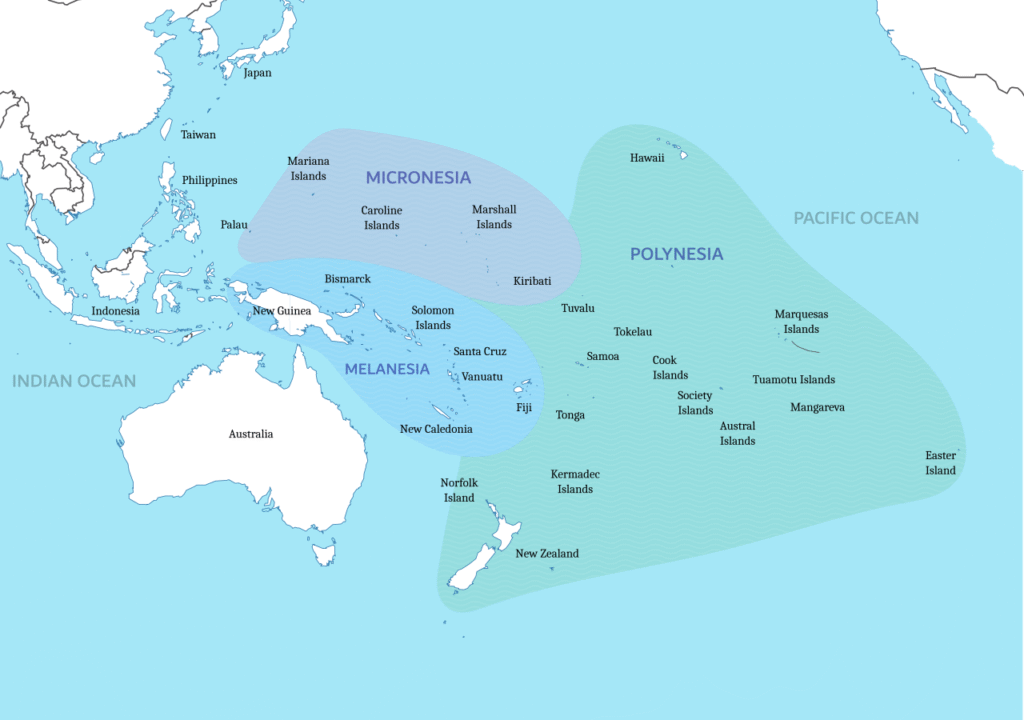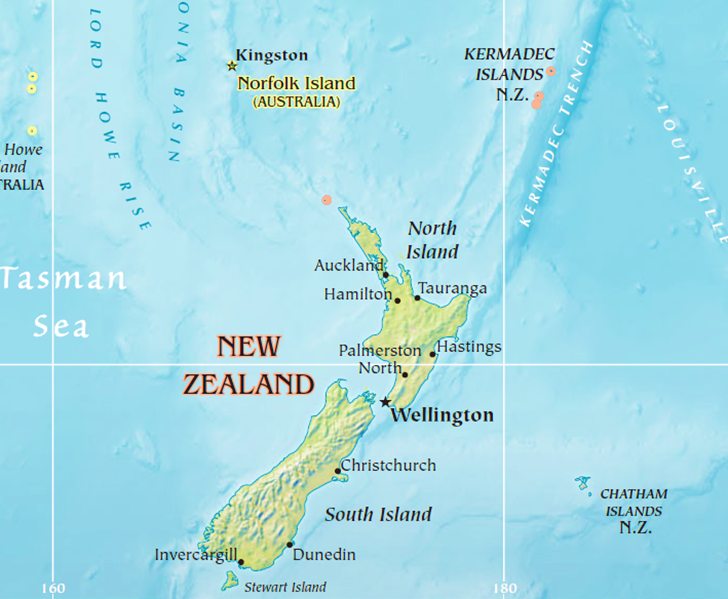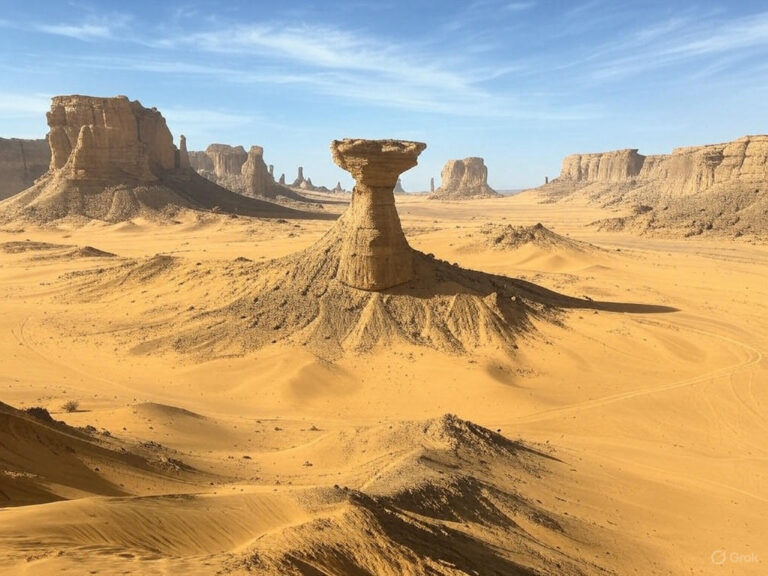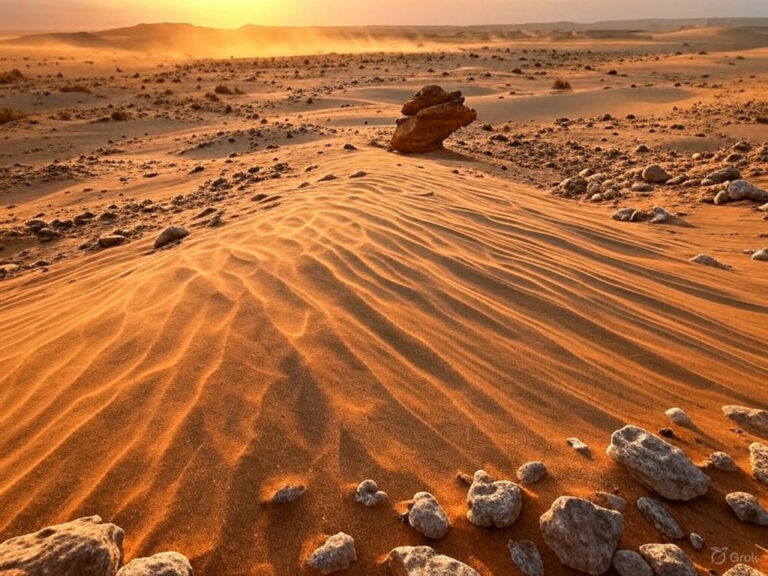Oceania
Imagine you’re standing on the eastern edge of Australia, looking out into the vast Pacific Ocean. What lies ahead isn’t just water—it’s an entire world scattered across it. This vast expanse of islands, grouped politically, culturally, and geologically, is called Oceania.

🔹 Four Traditional Divisions of Oceania:
| Region | Key Components |
| Australasia | Australia and New Zealand |
| Melanesia | Includes Papua New Guinea, Fiji, Solomon Islands, Vanuatu |
| Micronesia | Includes Marshall Islands, Palau, Nauru, Kiribati, etc. |
| Polynesia | Includes Samoa, Tonga, Tuvalu, Hawaii, Easter Island, etc. |
These divisions are based not only on geographical location but also on ethnic, linguistic, and cultural traits.
🏝️ Geological Division of Oceania – Island Formation Types
Here lies the beauty of Geography: beyond political borders, let’s understand how these islands were formed, because this influences everything from climate to soil fertility and even settlement patterns.
Continental Islands – Detached Pieces of Continents
| Feature | Description |
| Formation | Part of continental crust, broken off due to tectonic shifts or sea-level rise |
| Physical Geography | Mountains, deserts, rivers—diverse terrain |
| Examples | Australia, Zealandia (includes New Zealand), New Guinea |
🧠 Think of these as ‘continental cousins’ of the mainland—still large, fertile, and geologically ancient.
High Islands – Volcanic Peaks Born from Fire
| Feature | Description |
| Formation | Created by volcanic activity, often part of the Pacific Ring of Fire |
| Topography | High peaks, ridges, and valleys—very scenic and fertile |
| Examples | Mount Tomanivi (Fiji), Mount Lamington (Papua New Guinea), Mount Yasur (Vanuatu) |
🧠 These are the “young, fiery children” of the Pacific—dramatic landscapes, but prone to eruptions and earthquakes.
Low Islands (Coral Islands) – Nature’s Floating Necklaces
| Feature | Description |
| Formation | Built over time by coral reefs; low elevation, barely above sea level |
| Shape | Often form atolls—ring-shaped islands enclosing lagoons |
| Examples | Kwajalein Atoll (Marshall Islands), Kiribati (32 atolls + 1 island) |
🧠 These are “fragile oceanic gems”—stunning to see, but highly vulnerable to climate change and rising sea levels.
🔁 Quick Comparison Table – Island Types of Oceania:
| Island Type | Origin | Elevation | Regions Dominated | Examples |
| Continental Islands | Detached from continent | High | Australasia | Australia, New Guinea, New Zealand |
| High Islands | Volcanic eruptions | High | Melanesia | Fiji, Papua New Guinea, Vanuatu |
| Low Islands | Coral reef build-up | Low | Micronesia, Polynesia | Kiribati, Marshall Islands |
We will now explore the three major subregions of Oceania in detail:
- 🌺 Melanesia – “Black Islands”
- 🌴 Micronesia – “Tiny Islands”
- 🐚 Polynesia – “Many Islands”

🌴 Melanesia – “The Black Islands”
Let’s begin with Melanesia, whose name literally means “Islands of Black People” (from Greek: melas = black, nesoi = islands). The term is a reference to the dark skin of the native inhabitants.
📍 Location & Extent
- Melanesia extends from New Guinea to Tonga in the western Pacific.
- Most of the region lies in the Southern Hemisphere, except some parts of Western New Guinea, which dip into the Northern Hemisphere.
🗺️ Key Countries & Territories
- Independent countries: Papua New Guinea, Fiji, Vanuatu, Solomon Islands
- Territories: New Caledonia (French Collectivity); Western New Guinea (Part of Indonesia)
🌿 Natural Features
- Climate: Predominantly tropical and humid.
- Vegetation: Rich rainforests cover much of the region.
🇫🇯 Fiji – Volcanic Islands, Sugar, and Indo-Fijians
- Volcanic Origin: Fiji is a group of volcanic islands located north of New Zealand in the Pacific.
- Major Islands:
- Viti Levu (largest) – located west of the Koro Sea
- Vanua Levu – second-largest
- Colonial Legacy:
- Became a British colony in 1874.
- Large-scale import of indentured Indian labourers in the 19th century for sugarcane plantations.
- Gained independence in 1970.
🧑🤝🧑 Demographic Note:
- Native Fijians – 54%
- Indo-Fijians – 38.1%
(Important for UPSC – links with India’s diaspora and diplomatic ties.)
🌊 Micronesia – “Tiny Islands”
From “Black Islands” (Melanesia), we now move to “Tiny Islands” — the literal meaning of Micronesia.
📍 Location
- Lies in the western Pacific Ocean.
- Comprises thousands of small islands, mainly coral atolls with a few volcanic islands.
🗺️ Political Divisions
There are four main island groups in Micronesia:
| Main Island Groups | Key Countries/Territories |
| 1. Caroline Islands | Federated States of Micronesia and Palau |
| 2. Gilbert Islands | Republic of Kiribati |
| 3. Mariana Islands | Guam and Northern Mariana Islands (unincorporated U.S. territories) |
| 4. Marshall Islands | Sovereign nation; includes Kwajalein Atoll (one of world’s largest) |
Note:
- Wake Island: lies in Marshall Islands which is controlled by US Air Forces but claimed by Marshall Island.
- Nauru: small sovereign Island Nation in Micronesia region.
🪸 Geography Note:
- Most islands are atolls—ring-shaped coral formations surrounding a lagoon.
- Important examples:
- Kwajalein Atoll (Marshall Islands)
- Nukuoro Atoll (Federal States of Micronesia)
🌺 Polynesia – “Many Islands”
Polynesia is the most widely scattered group in Oceania. The term itself means “many islands” (Greek: poly = many, nesoi = islands).
🔺 Polynesian Triangle
Visualise a triangle across the Pacific:
| Triangle Corners |
| Hawaiian Islands (North) |
| New Zealand (Southwest) |
| Easter Island (Rapa Nui) (Southeast) |
🔹 Islands within this triangle: Samoa, Tonga, Tuvalu, etc.
🔹 Outside the triangle: Some parts of Solomon Islands and Vanuatu also host Polynesian enclaves.
🗺️ Key Countries and Territories
Independent nations:
- New Zealand, Samoa, Tonga, Tuvalu, Vanuatu, and the Solomon Islands
Other Territories
- American Samoa: Unincorporated territory of the United States located to the southeast of Samoa.
- Cook Islands: Self-governing state in free association with New Zealand.
- Easter Island: Province and special territory of Chile.
- French Polynesia: Overseas country of the French Republic.
- Hawaii: In 1959, Hawaii became the 50th state of the US (Alaska – 49th state; purchased from Russia).

🇳🇿 New Zealand
New Zealand isn’t just a member of Oceania; it’s also the largest country in Polynesia.
📌 Geography
- Comprises two main islands:
- North Island – home to Wellington (capital) and Auckland (largest city)
- South Island – agriculturally rich and scenically dramatic
🏔️ Southern Alps
- Mount Cook (Aoraki) – highest peak
- Role: Divides the wet, forested western slopes and the drier eastern plains like Canterbury and Marlborough.
🚜 Economy
- South Island: Forestry, agriculture, sheep rearing, dairy
- North Island: Urban centres, ports, population hubs
🧠 Remember: New Zealand combines the volcanic traits of high islands with temperate climate, making it unique in Polynesia.
🔁 Final Recap Table – Melanesia, Micronesia & Polynesia
| Region | Meaning | Landform Type | Key Examples |
| Melanesia | Black Islands | Mostly volcanic & continental | PNG, Fiji, Vanuatu, Solomon Islands |
| Micronesia | Tiny Islands | Predominantly atolls | Kiribati, FSM, Palau, Marshall Islands |
| Polynesia | Many Islands | Atolls & volcanic islands | NZ, Tonga, Samoa, Hawaii, Easter Island |





One Comment